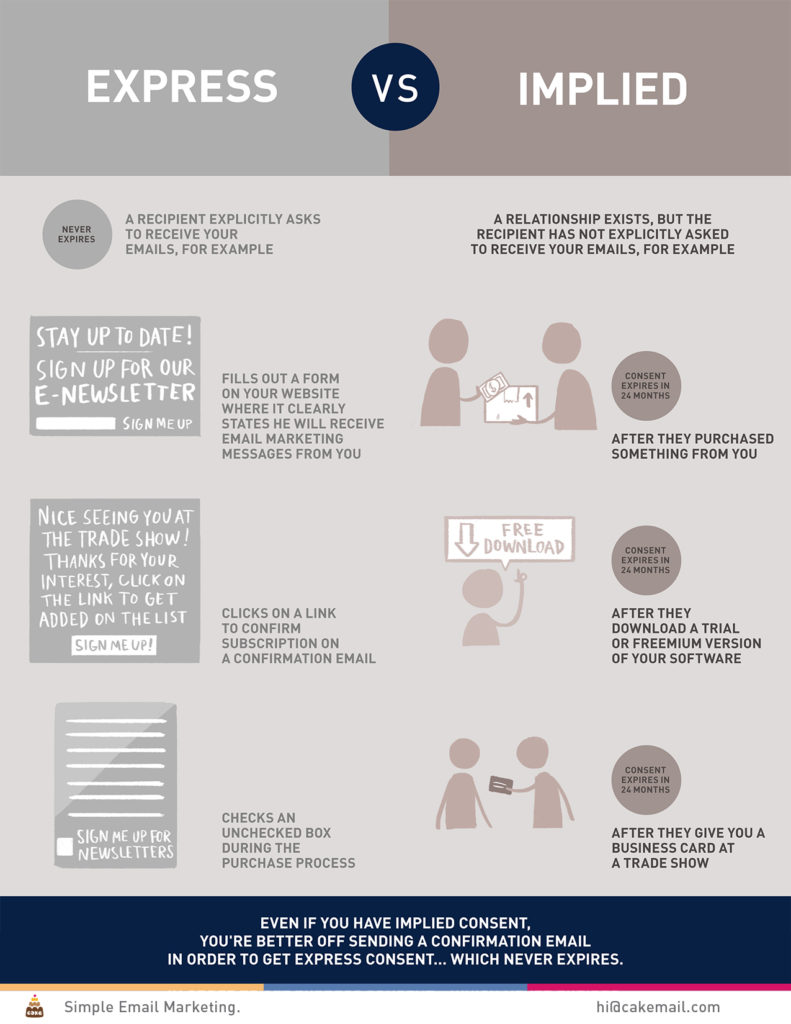
July 1st is just over a week away, and I'm still hearing about businesses who are just now learning about the new Canadian Anti-Spam Legislation (CASL). If you're just hearing about it now, we have some work to do (but that's ok, that's what I'm here for). To be fair, I wasn't giving it much thought at all either until maybe a couple weeks ago. While I had heard rumblings, I thought it was just another spam law targeting those V1agra and Nigerian prince spammers, who I don't understand how they still function. They know the secret's out, right?
But it turns out CASL is a bit different. CASL drastically changes the way businesses are able to approach marketing. The days of compiling massive email lists and sending out a blast are over, and the importance of inbound marketing and putting out remarkable content is amplified exponentially. Don't like it? Too bad, you can get tagged with a hefty fine if you choose not to comply.
Even if you choose to comply, it can be difficult to really understand what you actually need to comply to. As with any new legislation, they don't exactly lay it out on a platter. After a half-an-hour debate at work on what we should and shouldn't do, I realized that none of us could really back up our arguments with any factual knowledge. Because of the great implications, and because digital marketing is where I play, I took the liberty to understand the new legislation as much as I possibly could. The next few days were painful, but the resulting gratification was abundant.
Here is my best attempt at simplifying CASL, and it's impact on your marketing efforts. Here is my best attempt at taking the hassle out of learning CASL (you don't know how long I've been waiting to use that one):
Please let me know in the comment box below if you have any questions, if there's something I missed, or if there's something you think I'm wrong about. Thanks!
Text version:
INTRODUCTION TO THE CANADIAN ANTI-SPAM LEGISLATION & ITS IMPACT ON YOUR BUSINESS
BUT FIRST...
In my 2nd year of university, I got a B+ in my Business Law class. I was not good enough at law to be a lawyer then, and I am certainly not good enough now. The following is simply my interpretation of the new legislation, and should not be taken as or substituted for legal advice or guidance. Repeat, I am not a lawyer.
WHAT IS IT?
- New legislation that is aimed to minimize the receipt of unsolicited commercial messages
- It has been in the works for years, but is coming into effect and being enforced on July 1st, 2014
WHAT DOES IT COVER?
- More than just email -- it also covers texts, IMs, and automated cell phone messages sent to computers/phones in Canada (Commercial Electronic Messages – CEMs)
- Only applies when the recipient is located in Canada
WHY SHOULD YOU CARE?
- Very hefty fines!
- Up to 1M for individuals, 10M for businesses
HOW IT WILL BE ENFORCED
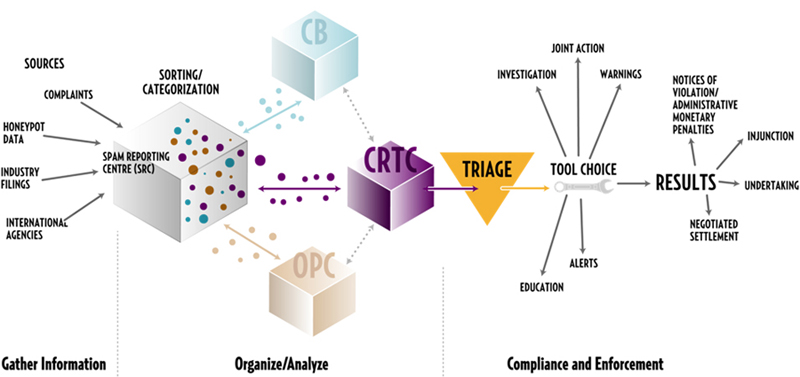
- At this point, it would be foolish to assume ‘nothing will ever happen to me.’
3 MAIN COMPONENTS
- Consent
- Identification Information
- Unsubscribe mechanism
1. CONSENT
- 2 Types of Consent:
- Express
- The person has explicitly told you they’d like to receive your CEMs
- Implied
- There is an existing business or non-business relationship
- The burden of proof lies on you, the sender
EXPRESS CONSENT
- The recipient explicitly asks to receive your emails, for example:
- Fills out a form on your website where it clearly states they will start receiving marketing messages from you
- Clicks on a link to confirm subscription in a confirm subscription email
- Checks an unchecked box when filling out a form on your website
- Express consent never expires
EXPRESS CONSENT - TOGGLING
- Can’t have the consent box pre-checked
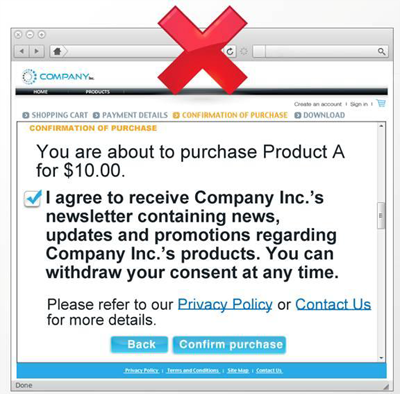
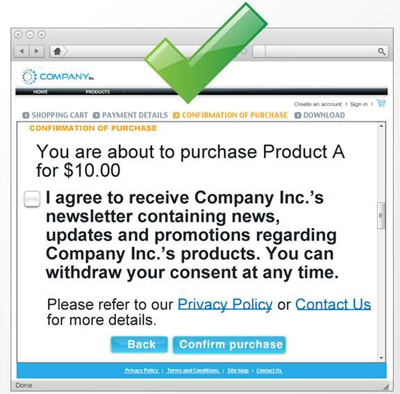
EXPRESS CONSENT - BUNDLING
- Requests for consent must be “sought separately”
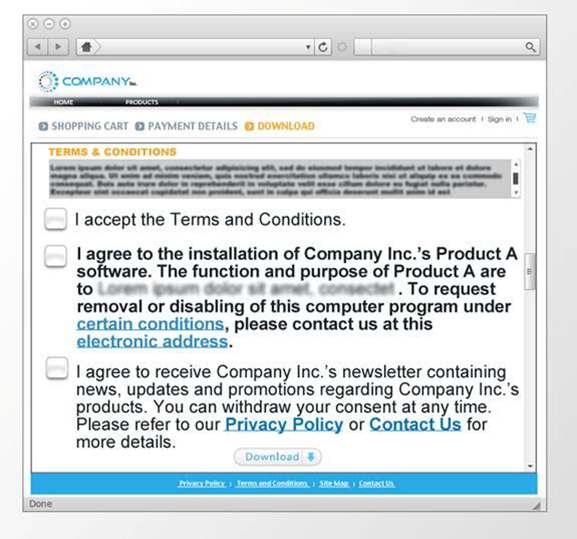
EXPRESS CONSENT - ORAL
- Since the burden of proof is on the sender, if someone gives you oral consent, you need to have either a 3rd party witness or a recording of the conversation
- Both of these are impractical, so it’s best to follow up with an email immediately after the conversation to confirm express consent
IMPLIED CONSENT
- A relationship exists, but the person has not explicitly asked to receive your emails
- After they purchase something from you
- After they download free content on your website
- After they give you a business card at a tradeshow (unless they ask not to receive emails)
- Consent is implied within a 24-month period following the last transaction
- If they have only made an inquiry, it is implied for 6 months after the inquiry
- * There is a transition period until July 2017, where the 24 month and 6 month time restriction do not apply
- Ex someone could have purchased something from you 25 years ago, and you’d still have implied consent
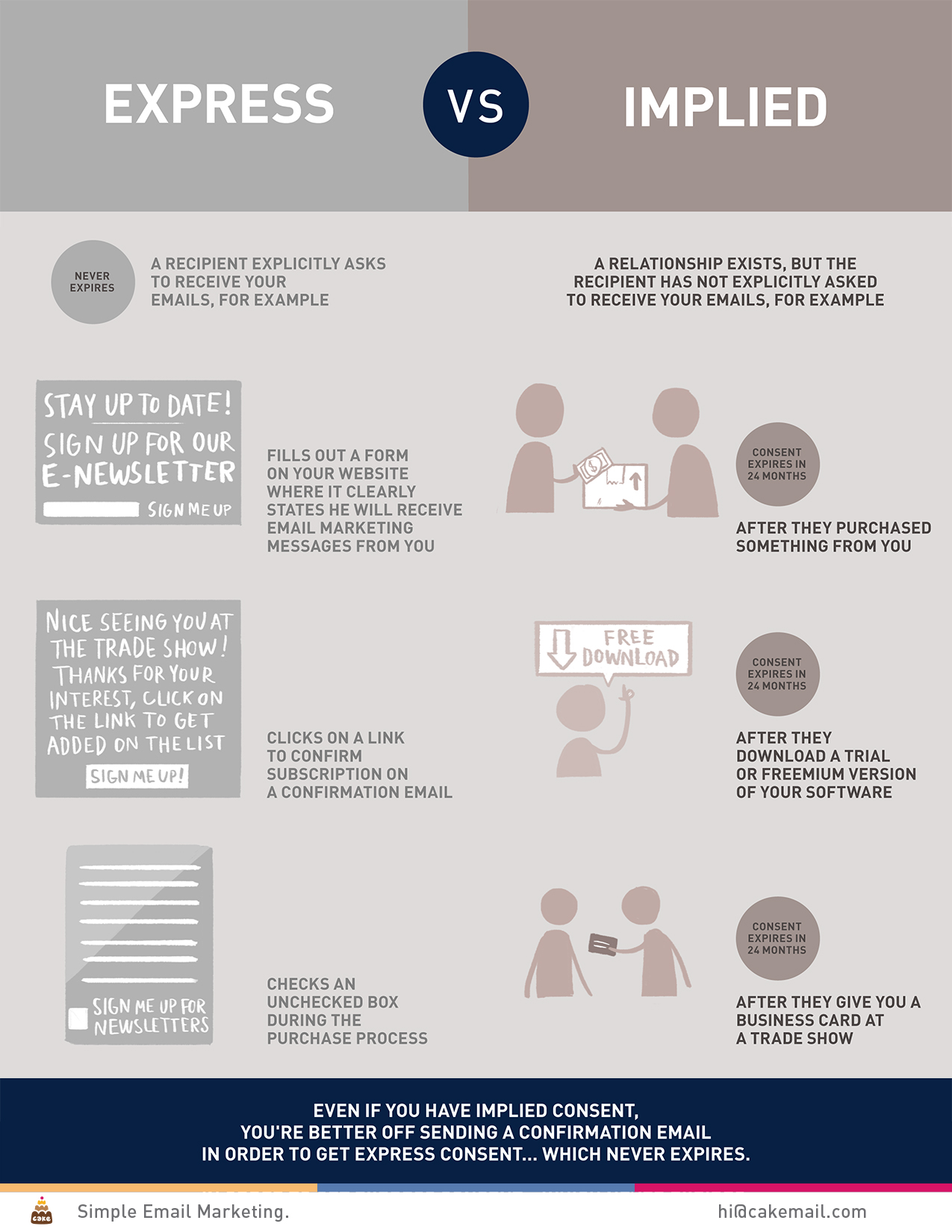
WHEN YOU DON’T NEED CONSENT
- The recipient isn’t in Canada (need to follow their country’s spam law though)
- When messaging people in your own organization
- When messaging someone in another organization that you have a relationship with, as long as it concerns the activities of the business
- Responding to a request, inquiry, complaint, or providing a quote or estimate
- It is not a CEM (purpose isn’t to encourage participation in commercial activity)
- If a person/organization has made their email publicly available (and it doesn’t say please no spam/CEMs), you are able to contact them
WHAT ABOUT MAILING LISTS?
- It doesn’t matter if the list is free or paid, the same rules apply for each person on the list. They must have given you express or implied consent for you to be able to send them a marketing message.
2. IDENTIFICATION INFORMATION
- For every CEM, you must give your identifying/contact information as well as the contact info of anyone else you're getting the consent on behalf of
- Name, mailing address, and a phone number or email in which they can contact you
3. UNSUBSCRIBE MECHANISM
- Person must be able to easily unsubscribe
- Can be a link in the email that takes them to a page where they can change preferences
- If a text, allow them to text STOP to unsubscribe
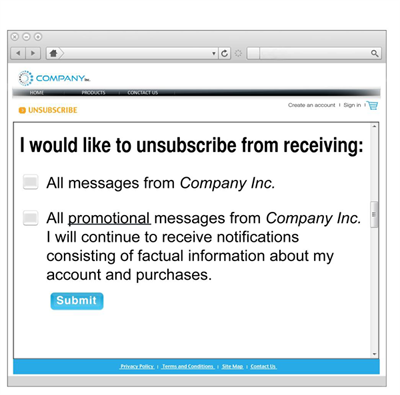
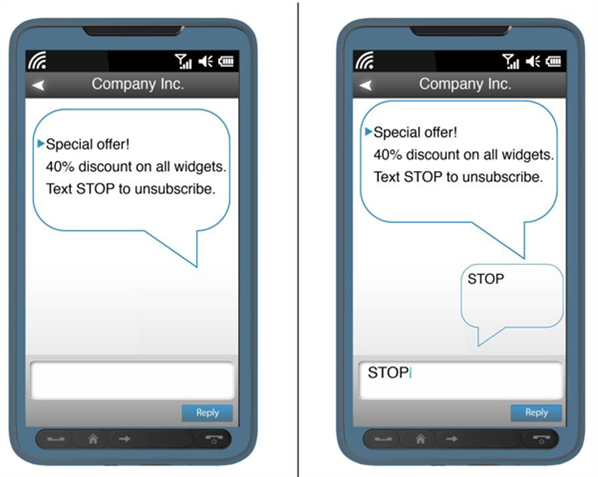
OTHER FUN STUFF
- Registered charities and political parties are exempt
- Consent is not required to send the first CEM from a referral
- Referral must have existing relationship with both parties (business, non-business, family or personal)
- You must state that your message is a result from a referral, and the name of the person who referred you
- Sending a personal message to someone on social media is considered a CEM
- If you are a part of an association or club, there is implied consent, and you can send to other members in the organization
- Must include identification and unsubscribe
- The organization must be a non-profit
WHAT THIS MEANS
- Starting July 1st 2014, if you don’t have express or implied consent from a lead, you can no longer email them
- Try to get consent from them before July 1st!
- Need to make the technical changes (to your email template, landing pages etc), as well as developing new policy to ensure you’re complying with the legislation
SAMPLE TASK LIST
- Before July 1st:
- Segment your list, email leads in Canada who you don’t have a relationship with asking if they’ll give their consent (example on next slide)
- Add identification information and unsubscribe mechanism to your email templates
- Review policy with marketing team
- Add express consent checkboxes to your existing landing pages and forms
CONSENT REQUEST EXAMPLE
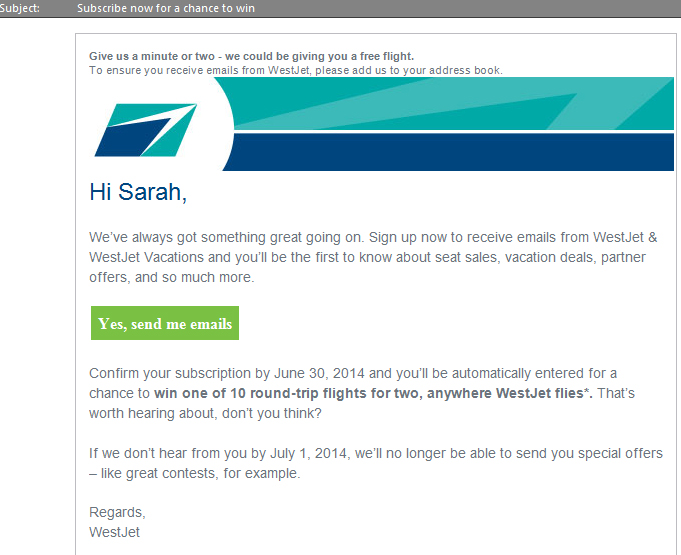
http://stryvegroup.com/casl-consent-emails-terrible/ is a great resource on how to craft a consent request email that doesn’t suck.
SAMPLE TASK LIST
- Before or After July 1st:
- Goal is to always get express consent!
- Good practice to get this from everyone, not just people located in Canada
- Make sure your landing pages and sign up forms are optimized
- You have 3 years to get leads/contacts with implied consent to give express consent
- Keep track! Remember, the burden of proof is on you. Make sure you can pinpoint when the person gave you their express consent.
